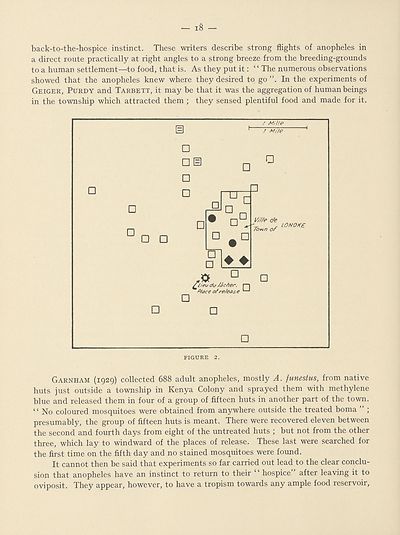Health > Housing and malaria
(20)
Download files
Complete book:
Individual page:
Thumbnail gallery: Grid view | List view

back-to-the-hospice instinct. These writers describe strong flights of anopheles in
a direct route practically at right angles to a strong breeze from the breeding-grounds
to a human settlement—to food, that is. As they put it: “ The numerous observations
showed that the anopheles knew where they desired to go ”. In the experiments of
Geiger, Purdy and Tarbett, it may be that it was the aggregation of human beings
in the township which attracted them ; they sensed plentiful food and made for it.
□
□
□
□ □
□
/ M/He
/ Mi/e
□
□
□
□
LONOKE
□
□
□
FIGURE 2.
Garnham (1929) collected 688 adult anopheles, mostly A. funestus, from native
huts just outside a township in Kenya Colony and sprayed them with methylene
blue and released them in four of a group of fifteen huts in another part of the town.
“ No coloured mosquitoes were obtained from anywhere outside the treated boma ” ;
presumably, the group of fifteen huts is meant. There were recovered eleven between
the second and fourth days from eight of the untreated huts ; but not from the other
three, which lay to windward of the places of release. These last were searched for
the first time on the fifth day and no stained mosquitoes were found.
It cannot then be said that experiments so far carried out lead to the clear conclu¬
sion that anopheles have an instinct to return to their “ hospice” after leaving it to
oviposit. They appear, however, to have a tropism towards any ample food reservoir,
a direct route practically at right angles to a strong breeze from the breeding-grounds
to a human settlement—to food, that is. As they put it: “ The numerous observations
showed that the anopheles knew where they desired to go ”. In the experiments of
Geiger, Purdy and Tarbett, it may be that it was the aggregation of human beings
in the township which attracted them ; they sensed plentiful food and made for it.
□
□
□
□ □
□
/ M/He
/ Mi/e
□
□
□
□
LONOKE
□
□
□
FIGURE 2.
Garnham (1929) collected 688 adult anopheles, mostly A. funestus, from native
huts just outside a township in Kenya Colony and sprayed them with methylene
blue and released them in four of a group of fifteen huts in another part of the town.
“ No coloured mosquitoes were obtained from anywhere outside the treated boma ” ;
presumably, the group of fifteen huts is meant. There were recovered eleven between
the second and fourth days from eight of the untreated huts ; but not from the other
three, which lay to windward of the places of release. These last were searched for
the first time on the fifth day and no stained mosquitoes were found.
It cannot then be said that experiments so far carried out lead to the clear conclu¬
sion that anopheles have an instinct to return to their “ hospice” after leaving it to
oviposit. They appear, however, to have a tropism towards any ample food reservoir,
Set display mode to:
![]() Universal Viewer |
Universal Viewer | ![]() Mirador |
Large image | Transcription
Mirador |
Large image | Transcription
Images and transcriptions on this page, including medium image downloads, may be used under the Creative Commons Attribution 4.0 International Licence unless otherwise stated. ![]()
| League of Nations > Health > Housing and malaria > (20) |
|---|
| Permanent URL | https://digital.nls.uk/191817758 |
|---|
| Shelfmark | LN.III |
|---|---|
| Description | Over 1,200 documents from the non-political organs of the League of Nations that dealt with health, disarmament, economic and financial matters for the duration of the League (1919-1945). Also online are statistical bulletins, essential facts, and an overview of the League by the first Secretary General, Sir Eric Drummond. These items are part of the Official Publications collection at the National Library of Scotland. |
|---|---|
| Additional NLS resources: |
|

